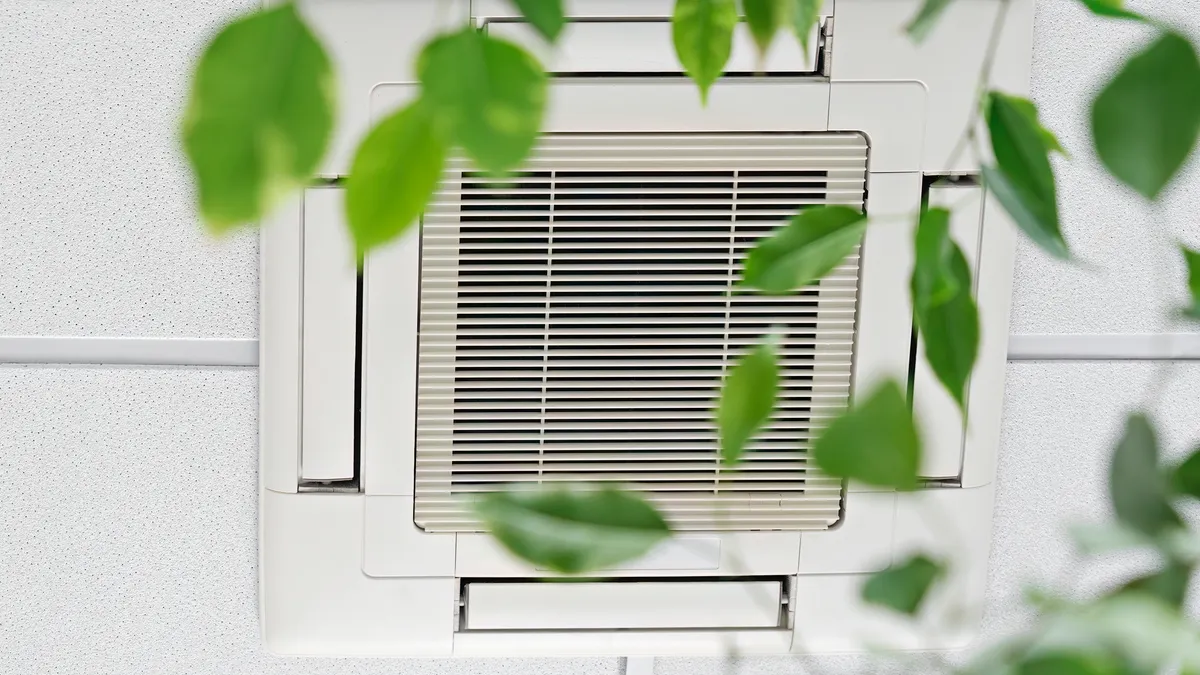Dive Brief:
- While operators can improve indoor air quality while increasing energy efficiency, they must be intentional about decision-making and operations to overcome barriers, according to experts from ASHRAE, the U.S. Green Building Council and the International WELL Building Institute.
- Indoor air quality can be enhanced without compromising on energy efficiency, but operators must address specific barriers such as insufficient accountability, split incentives and complexities in existing buildings, Seema Bhangar, principal of healthy buildings and communities at USGBC, said during a National Institute of Building Sciences webinar.
- Intentional design, planning and minimum performance standards, alongside regular monitoring, verification and efforts to ensure buildings work as designed, can help operators overcome these challenges, according to Bhangar’s presentation.
Dive Insight:
For many years, efforts to boost energy efficiency have taken precedence over improving indoor quality, causing negative impacts to indoor air quality, Bhangar said, noting a correlation between lower air change rates made in response to the 1970s energy crisis and the Sick Building Syndrome, a condition used to describe acute health- or comfort-related efforts related to time spent in the building. “During the COVID-19 [pandemic], we also saw the opposite,” Bhangar said. Although many people were isolated in quarantine during the pandemic, buildings were running at maximum ventilation round the clock, wasting energy, Bhangar said.
According to a 2022 ASHRAE analysis of the International WELL Building Standard, which measures and awards buildings based on principles of healthy design and operations, individual WELL building features can impact energy use at varying levels, with some features carrying an “energy penalty” that can increase energy use by about 9%. Other WELL features, however, can generate up to 11% in energy savings. Combining these ‘energy penalty features’ and ‘energy saving features’ could increase annual energy use by 53% to 78%, or yield 20% to 28% in potential energy savings, depending on the climate and implementation, Nathan Stodola, chief engineer at the International WELL Building Institute, said in another presentation. “So that’s where it comes in to pick the strategies that achieve your goals of improving human health while also being conscious about climate and energy,” Stodola said.
Other strategies to improve IAQ while managing energy use include right-sizing outdoor air filters, implementing demand-controlled ventilation, adopting displacement ventilation and using ultraviolet irradiation to combat mold growth in central air handling units, per Stodola’s presentation.
Many elements of “efficient indoor air quality” exist, including ways to benchmark and compare air quality, air cleaning and baseline sensor technologies, and performance paths to minimum IAQ standards, William Bahnfleth, professor at Pennsylvania State University and presidential fellow at ASHRAE, said during the seminar.
However, “[we] don’t have an educated workforce and this is not simply having people who can install and maintain systems,” Bahnfleth said. “It goes all the way back to … the engineer designing the building. What does the facility manager know about the importance of [indoor quality], so they can put the correct emphasis on it?”
Operators can meet and exceed required ventilation rates, providing acceptable indoor air quality standards without having to increase energy use, Bahnfleth said. “We have … as much consensus on the need to address air quality now as we’ve ever had, but I think it’s already fading from what I hear when we get outside of academic circles.”
“So we really need to act now if we're going to do something about it, or this moment will pass,” Bahnfleth added. Historically, indoor air quality requirements have only been changed at times of high public health concern, and there are currently no national standards for design “parallel to ASHRAE Standard 90.1 in the IECC” or regulations like the Clean Air Act for indoor air, according to Bahnfleth.
“The most serious gap is a regulatory one,” Bahnfleth said. “We make buildings for the people who will inhabit them, not to save energy. And that is consistent with what the World Health Organization said a long time ago: that free access to air and water of acceptable quality is a fundamental human right.”
“An energy declaration without a declaration related to the indoor environment makes no sense,” said Bahnfleth, quoting former ASHRAE president Bjarne Olesen, who is professor emeritus at the Department of Environmental and Resource Engineering at DTU Sustain.












